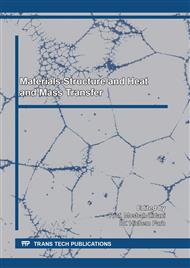p.229
p.240
p.250
p.256
p.265
p.274
p.285
p.292
p.300
Propolis Extract as Corrosion Inhibitor of Iron Alloy Immersed in an Ethylene Glycol / Water, 0.1 M NaCl Solution
Abstract:
The behaviour of a corrosion inhibitor based on proplolis extract via an iron alloy immersed in an electrolyte containing ethylene glycol water in NaCl 0.1 M was evaluated by a stationary technique not destructive which is the technique of electrochemical impedance. The diameter of the Nyquist curves increases with the increase of the concentration of propolis extract and it reaches an optimum concentration at 1.25 g / L, the maximum surface coverage percent at this concentration is 71.98% .The activation parameters reveal that the inhibitor molecules on iron surface are absorbed by physisorption and a chimisorption and obey Langmuir isotherm adsorption. These results were supplemented by Scanning electron microscopy (SEM) and (EDX) spectrum of chemical composition. The metal solution interface is simulated as a physical model by using electrochemical impedance spectroscopy (EIS). Keywords: Iron Alloy, Propolis extract, ethylene glycol;, Lamgmuir isotherm, Electrochemical impedance Spectroscopy (EIS).
Info:
Periodical:
Pages:
265-273
Citation:
Online since:
January 2021
Authors:
Price:
Сopyright:
© 2021 Trans Tech Publications Ltd. All Rights Reserved
Share:
Citation:


